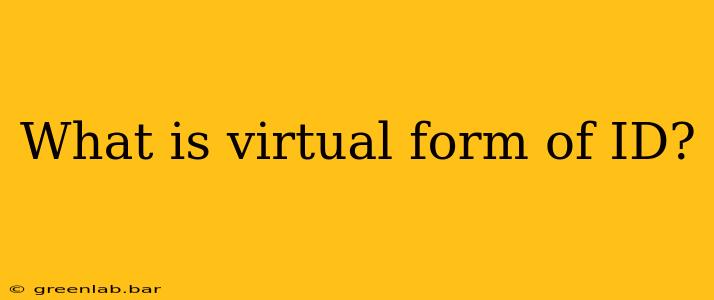In today's increasingly digital world, the need for secure and convenient identity verification has exploded. This has led to the rise of virtual forms of ID, offering a digital equivalent to traditional physical identification documents. But what exactly are they, and how do they work? Let's delve into the intricacies of this evolving technology.
Understanding Virtual IDs: Beyond Just a Digital Photo
A virtual ID, also known as a digital identity, isn't simply a scanned image of your driver's license or passport. It's a more sophisticated system encompassing various technologies to ensure authenticity and security. These systems aim to replicate the functionality of physical IDs but in a digital format, accessible through smartphones, computers, or other devices.
This means virtual IDs are more than just a picture; they often incorporate:
- Biometric Data: This could include fingerprint scans, facial recognition, or iris scans, adding an extra layer of security to verify identity.
- Digital Signatures: These provide irrefutable proof of authenticity and prevent tampering or forgery.
- Blockchain Technology: Some systems leverage blockchain for secure storage and management of identity data, enhancing transparency and immutability.
- Encryption: Protecting sensitive personal information is crucial. Strong encryption methods safeguard data from unauthorized access.
- Trusted Issuers: Government agencies or reputable private organizations are typically responsible for issuing virtual IDs, ensuring their legitimacy and trustworthiness.
Types of Virtual Identification
Several types of virtual IDs are emerging, each with specific applications and levels of security:
1. Mobile Driver's Licenses (mDLs):
Many states and countries are now piloting or implementing mobile driver's licenses. These are digital versions of physical driver's licenses, often stored in a dedicated mobile app. They typically include the same information as a physical license but offer added convenience and security features.
2. Digital Identity Platforms:
These platforms aggregate various forms of identification, such as passport information, driver's licenses, and other credentials, into a single, secure digital profile. This allows users to easily verify their identity across different online services and applications.
3. Virtual National IDs:
Some countries are developing national digital identity programs, providing citizens with a secure and universally accepted form of virtual identification for accessing government services, voting, and other official processes.
Benefits of Virtual IDs
The adoption of virtual IDs offers numerous advantages over traditional physical identification:
- Convenience: Access your ID anytime, anywhere, directly from your device.
- Enhanced Security: Biometric data and encryption significantly reduce the risk of fraud and identity theft.
- Efficiency: Streamlines identity verification processes for online transactions and services.
- Cost Savings: Reduces the need for printing, replacing, or mailing physical IDs.
- Environmental Friendliness: Contributes to a more sustainable approach by reducing paper consumption.
Challenges and Considerations
While virtual IDs offer significant advantages, challenges remain:
- Data Security and Privacy: Protecting sensitive personal information from breaches and misuse is paramount.
- Interoperability: Ensuring that different virtual ID systems can communicate and interact seamlessly is crucial for widespread adoption.
- Accessibility: Making virtual IDs accessible to all segments of the population, regardless of technological literacy or access to technology, is essential.
- Regulation and Standardization: Clear regulations and standards are needed to ensure the security, reliability, and trustworthiness of virtual ID systems.
The Future of Virtual IDs
Virtual forms of ID are poised to become increasingly prevalent as technology advances and the demand for secure and convenient digital identity solutions grows. As the technology matures and addresses existing challenges, we can expect even greater integration of virtual IDs into our daily lives, transforming how we verify our identities in both the physical and digital realms. The future of identity is undoubtedly digital, and virtual IDs are at the forefront of this transformation.

